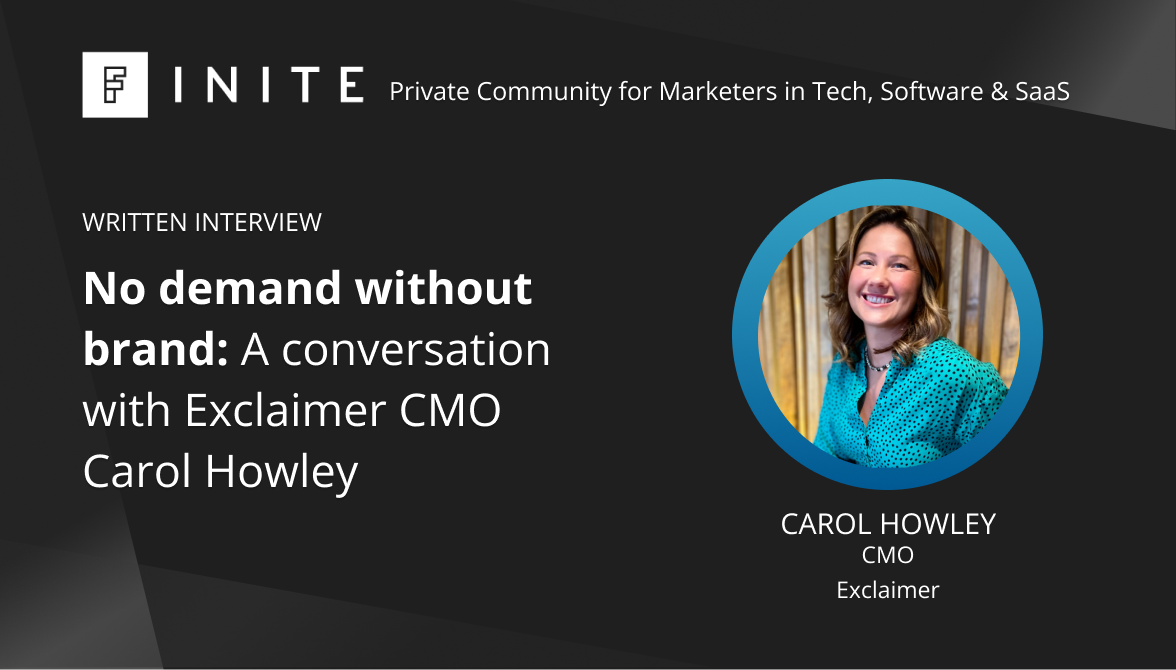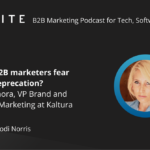FINITE sat down with esteemed tech CMO, Carol Howley, to discuss the changing B2B climate and the role of brand to defend against the collapse of traditional B2B funnels.
Read the interview to learn:
- How the role of brand investment is evolving
- Metrics and KPIs to track brand
- How B2B companies can overhaul their demand generation strategies
How significant is the role of brand activation in the current market climate, especially as more buyers conduct their own research away from traditional sales funnels?
Brand activation plays a crucial role in the current market climate. With so many digital channels and platforms available, consumers have more access to information and choices than ever before. Brand activation helps companies cut through the marketing noise and connect with their target audience in meaningful ways. 74% of consumers say they are more likely to make a purchase after attending a branded event. It involves creating engaging experiences, content, and interactions that resonate with consumers and drive action. In a landscape where buyers are empowered and often make decisions based on brand perception and experience, effective brand activation can be a key differentiator for businesses.
Can you share your thoughts on the importance of a strong brand, and why companies should invest in this area?
A strong brand is essential for several reasons. Firstly, it builds trust and credibility with consumers, making them more likely to choose your products or services over competitors – 66% of customers name trust as the most important factor in feeling connected to a brand. A strong brand also fosters loyalty and advocacy, as satisfied customers turn into brand ambassadors, driving repeat business and referrals. Additionally, a strong brand can command premium pricing, as consumers are willing to pay more for products or services they perceive as higher quality or aligned with their values. Investing in your brand is the easiest way to drive and maintain growth. In fact, firms with long-term strategies such as brand investment have 47% more top-line growth than other companies. Cultivating a strong brand leads to long-term sustainable growth and competitive advantage in the market.
How is the role of brand investment evolving in the new marketing landscape, particularly in terms of long-term ROI over short-term metrics?
While short-term metrics such as instant sales and conversions are important, companies increasingly recognize the value of brand building activities that contribute to long-term brand equity and customer lifetime value. This shift is driven by the understanding that building a strong brand requires consistent investment and nurturing over time. A 14-year study by McKinsey & Company revealed that the top ranked brands outperformed the world market in terms of shareholder returns by 74%. Therefore, companies are increasingly focusing on metrics such as brand awareness, perception, loyalty, and advocacy to measure the effectiveness of their brand-building efforts and their impact on demand generation and overall business performance.
Can you share some details about the decision to rebrand Exclaimer? Why do you think a rebrand was necessary to boost demand?
The decision to rebrand Exclaimer was necessary to boost demand by revitalizing the brand’s image, relevance, and appeal in the market. A rebrand can help companies stay current with evolving market trends, technology, and consumer preferences. It provides an opportunity to reposition the organization, differentiate itself from competitors, and better align with the company’s vision, values, and target audience. By refreshing Exclaimer’s brand identity, messaging, and positioning, we aimed to attract new customers, re-engage existing ones, and drive demand for our products and services in a competitive market landscape.
What metrics or KPIs are you tracking to measure the long-term success of your brand-building activities in demand generation?
To measure the long-term success of brand-building activities in demand generation, we’re tracking metrics such as brand awareness, brand sentiment, customer engagement, and brand loyalty. These metrics provide insights into how well the brand is resonating with our audience, driving consideration and preference, and ultimately influencing purchase decisions. Additionally, we’re monitoring indicators of customer lifetime value, such as repeat purchases, referrals, and customer advocacy, to assess the long-term impact of brand-building efforts on revenue and profitability.
What are some of the common challenges businesses face while activating their brand and how can we overcome them?
Common challenges businesses face in activating their brand include inconsistent messaging, lack of differentiation, limited resources, and difficulty measuring ROI. To overcome these challenges, businesses can develop a clear brand strategy that defines their unique value proposition, target audience, and key messages. They should ensure consistency across all brand touchpoints – consistent brand presentation across all platforms can increase revenue by up to 23% – and invest in building brand awareness through strategic marketing initiatives. Leveraging customer feedback and data analytics can help refine brand activation efforts and measure their impact on business outcomes.
For companies that may be looking to overhaul their demand generation strategies, what initial steps or advice would you offer based on these new market dynamics?
For companies looking to overhaul their demand generation strategies, I would recommend conducting a thorough audit of their current marketing efforts, including audience segmentation, messaging, channels, and metrics. This will help identify areas for improvement and guide the development of a revised strategy aligned with new market dynamics. Additionally, companies should prioritize investments in brand building, content marketing, and customer experience initiatives to drive long-term growth and competitiveness in the digital landscape.
What advice would you give to emerging marketers looking to establish a sustainable, long-term brand presence and demand generation strategy in an increasingly competitive digital landscape?
Emerging marketers should focus on building authentic relationships with their target audience. This involves understanding customer needs and preferences, delivering valuable content and experiences, and consistently communicating the brand’s unique value proposition. 67% of consumers say they must trust the brand before they purchase its products or services. It’s also important to stay agile and adaptable, continuously learning and experimenting with new tactics and technologies to stay ahead of the curve.
With the importance of content and narrative in branding and demand generation, how can we ensure our marketing output is both high-quality and resonant with our target audience?
Companies should prioritize understanding their audience’s needs, interests, and pain points. This involves conducting thorough market research and persona development to tailor content narratives and messaging. Breaking through constant marketing distractions requires being consistent in your communications. Honing your narratives and brand voice allows you to deliver strong and consistent messaging across all channels and at every stage of the funnel. This will inevitably increase the likelihood of your message landing. Messages delivered as stories can be up to 22 times more memorable than just the facts.
Additionally, investing in content creation capabilities, such as hiring skilled writers, designers, and videographers, can help produce engaging and impactful content that resonates with the target audience across various channels and formats. Regularly getting feedback and analyzing performance metrics can also help optimize content quality and effectiveness over time.










